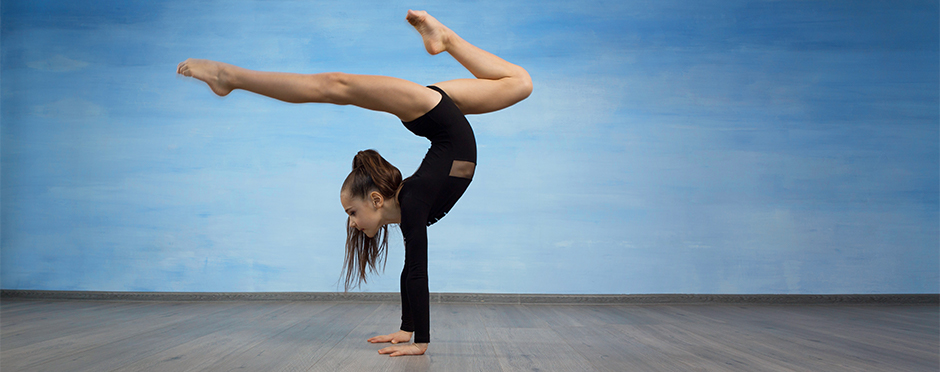
Concussions in Gymnasts: Symptoms and Treatment
Leave a CommentGymnastics is considered a high risk sport for head and neck injuries. A concussion is a traumatic brain injury that can occur from a direct or indirect force on the head. In gymnastics this can be the result of falling on the head, collision with equipment, collision with another athlete, or a fall where the head does not directly take the blow but a whiplash type movement occurs. In each of these scenarios, the brain moves rapidly inside the skull.
It is important for athletes, coaches, and parents to be able to identify the signs and symptoms of a possible concussion for appropriate medical care to be provided.
Concussion symptoms:
Any one or more of the following signs and symptoms may indicate a head injury:
- Headache
- Nausea or vomiting
- Dizziness
- Difficulty with balance
- Blurred or double vision
- Light and noise sensitivity
- Feeling sluggish, foggy or groggy
- Memory or concentration problems
- Altered sleep patterns
Signs observed by coaches or other team members that may indicate a concussion has occurred:
- Stunned or confused appearance
- Forgetfulness
- Confusion about routines
- Unsure of surroundings
- Inability to name current venue, date, or time
- Moves clumsily
- Loss of consciousness (long or short)
- Personality or behavior changes
- Forgets events right before or after a blow to the head
If a head injury or concussion is suspected, the athlete should be cleared by a health care concussion specialist prior to returning to sport.
Treatment For Concussions
Concussion treatment has evolved and a more active rehabilitation is recommended. Initial management involves eliminating aggravating stressors, which can include reading, computers, phones, tablets, light and loud noises. Physical therapy for concussions can include management of neck pain, headaches, vestibular rehabilitation for dizziness and balance disturbance, cardiovascular activities and vision training.
Gymnasts have unique aspects of their sport, tumbling for example, which may pose a challenge to return to sport after concussion. In general, gymnasts are recommended to progress slowly under the supervision of a concussion trained health care provider with new activities being introduced every 24 hours so long as recurrence of symptoms does not occur. See below for broad guidelines for concussion management for gymnastic athletes:
- Phase 1: No activity- cognitive and physical rest
- Phase 2: Limited activity- stretching, non-impact cardio for 15-20 minutes
- Phase 3: Low risk gym specific activity- no flipping, no twisting, no inversion. Examples: leaps, jumps, low beam, basic dance
- Phase 4: High risk gym specific activity- basic flipping, increasing inversion. Examples: add basics to bars/rings, start jumping and basic tumbling, can begin adding lifts for acrobatic athletes
- Phase 5+: Skill progression all events, higher difficulty flipping, gradual increase in tumbling, add twisting lastly, begin running partial routines, gradual return to full routines and all skills
Concussion Return to Participation – Gymnastics4
| Stage | Activity | Gymnastics Specific Exercises | Objective of the Stage |
| 1 | Symptom-limited activity |
|
|
| 2 | Light aerobic activity |
|
|
| 3 | Sport-specific exercise |
|
|
| 4 | Vertical work (Non-contact training drills) |
|
|
| 5 | Full Practice (after medical clearance) |
|
|
| 6 | Return to full participation |
|
|
Full return to participation should be based on the following: complete symptom resolution, tolerating all academic work, successfully completed exertion protocol and clearance by treating physician.
Tips to prevent concussions in gymnasts:
- Ensure proper mats and equipment setup
- Always have trained spotters in place at practice and competition
- Instruct gymnasts in proper technique
- Ensure athletes pay attention during practice to prevent collisions or distractions
Click here to learn more about Athletico’s concussion and vestibular rehabilitation services, or click the button below to request an appointment at a clinic near you.
The Athletico blog is an educational resource written by Athletico employees. Athletico bloggers are licensed professionals who abide by the code of ethics outlined by their respective professional associations. The content published in blog posts represents the opinion of the individual author based on their expertise and experience. The content provided in this blog is for informational purposes only, does not constitute medical advice and should not be relied on for making personal health decisions.
References:
1. “Concussion Fact Sheet for Athletes.” USA Gymnastics, www.usagym.org/pages/education/pdfs/concussion_athletes.pdf.
2. “Concussion Awareness for the Gymnastics Community .” USA Gymnastics, Concussion Awareness for the Gymnastics Community
3. “Pediatric Sports Specific Return to Play Guidelines Following Concussion.’ May et al. IJSPT 2014
4. May, Keith H et al. “Pediatric sports specific return to play guidelines following concussion.” International journal of sports physical therapy vol. 9,2 (2014): 242-55.
